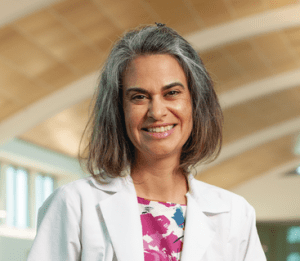 Breast Cancer Awareness With Dr. Manoli
Breast Cancer Awareness With Dr. Manoli
During Breast Cancer Awareness month, Sabine H. Manoli, M.D., FACS, a breast surgeon at the St. Joseph Hospital Breast Care Center, answers questions about maintaining breast health.
What are the best ways to find breast cancer early?
The 2D mammogram has largely been replaced by 3D mammograms for early detection of breast cancer, especially in dense breasts. Combined with monthly self-exams, these are our best tools. Other ways of finding breast cancer are ultrasound, breast MRI and needle biopsy to confirm if lumps are cancerous.
Why are yearly mammograms important?
The earlier you find breast cancer, the more treatment options you have and the better your long-term survival. The American Society of Breast Surgeons recommends mammograms start in most women at age 40 or in high-risk women with a family or personal history of breast or ovarian cancers or mutations in BRCA-1 or BRCA-2 genes at earlier risk-determined ages. I had breast cancer at age 45, and if I hadn’t had my mammogram, it would not have been discovered until much later.
What’s the best time to do a breast self-exam?
For women still menstruating, start doing self-exams at age 18 every month the week following your cycle. After menopause, continue monthly self-exams when you flip to a new calendar month, as a simple reminder. What should I look for in a breast self-exam? Normal breast tissue does not feel perfectly soft like a pillow. Self-exams help you become aware of normal lumps or bumps for you. If a lump changes, becomes more firm, or gets larger, see your doctor.
How do I perform an exam?
There are three parts to breast self-exams. While lying down with your arms overhead, use your opposite hand to feel each breast. Using several grouped fingers in a small circular or lawnmower pattern, search your breast from your collarbone to your ribs and armpit to cleavage. Use light, medium and firm pressure to search all layers of your breast tissue. Follow the same process while sitting. Finally, look at your breasts in the mirror with hands on your hips and also with arms overhead. Call your doctor immediately if you notice any of the following:
- Lumps, redness or swelling in the breast
- Skin dimpling, thickening or puckering
- Changes in breast size or shape
- Changes in the nipple, such as nipple inversion or non-milky discharge
- Swollen lymph nodes under the arm